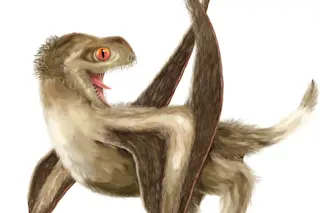The discovery of novel filaments on two species of pterosaur suggests that the extinct flying reptiles had complex coats of “feathers” and fuzz, say the authors of a new study. The presence of these apparent pterosaur feathers may indicate that the ancestor of both pterosaurs and their cousins, dinosaurs, sported similar coverings — but that’s not the only hypothesis.
Like dinosaurs, pterosaurs are archosaurs. This group of reptiles, which also includes crocodilians, likely emerged in the Late Permian Period (more than 250 million years ago) and dominated the Mesozoic Era that followed. Archosaurs abounded, all the way up until about 66 million years ago and the end-Cretaceous mass extinction, which spared only one dinosaur lineage (birds) and some crocodilians.
True feathers, with complex, branched structures, have been found on several theropods — one of the main branches of the dinosaur family tree and the lineage that includes birds. Less complex ...














